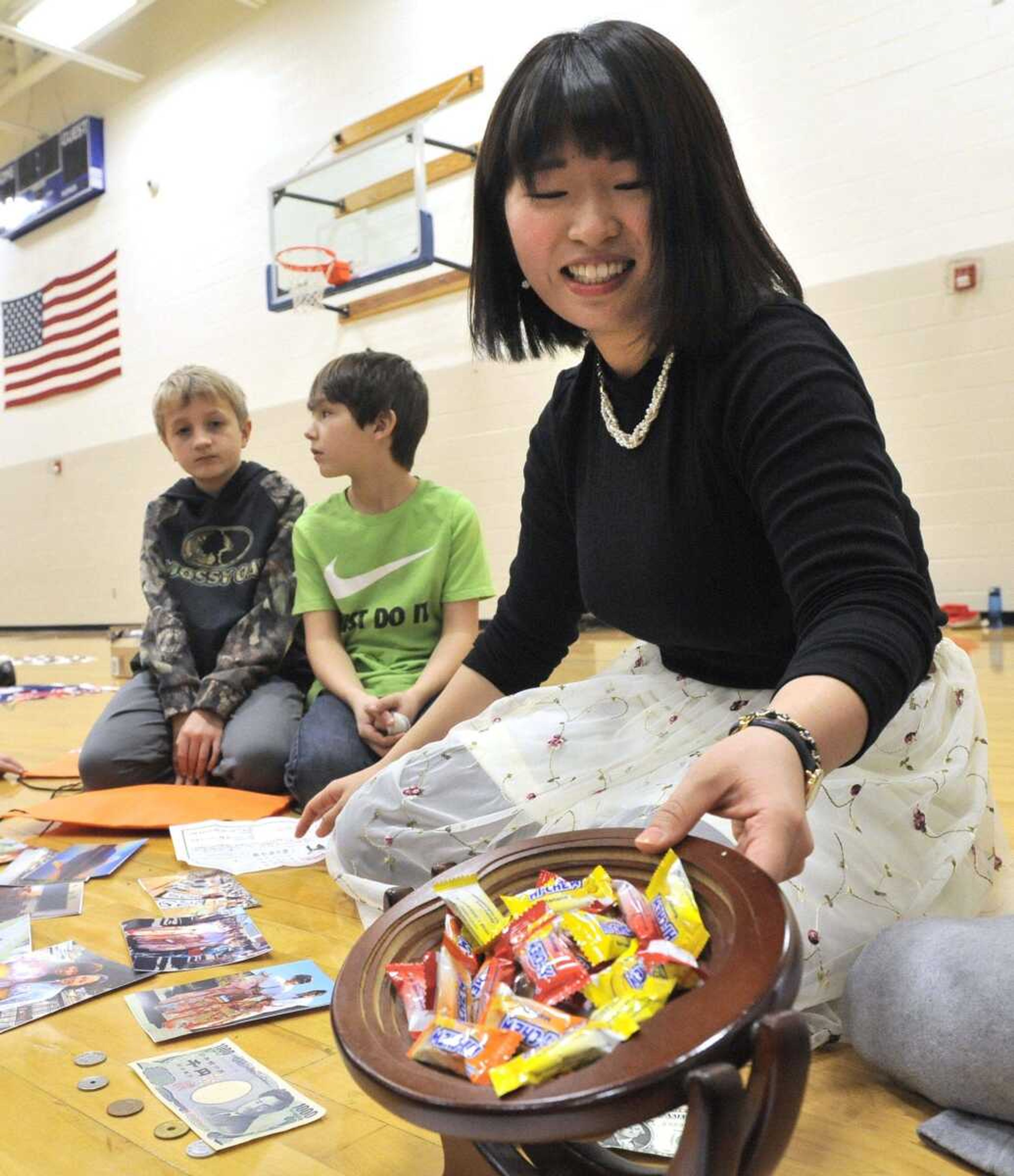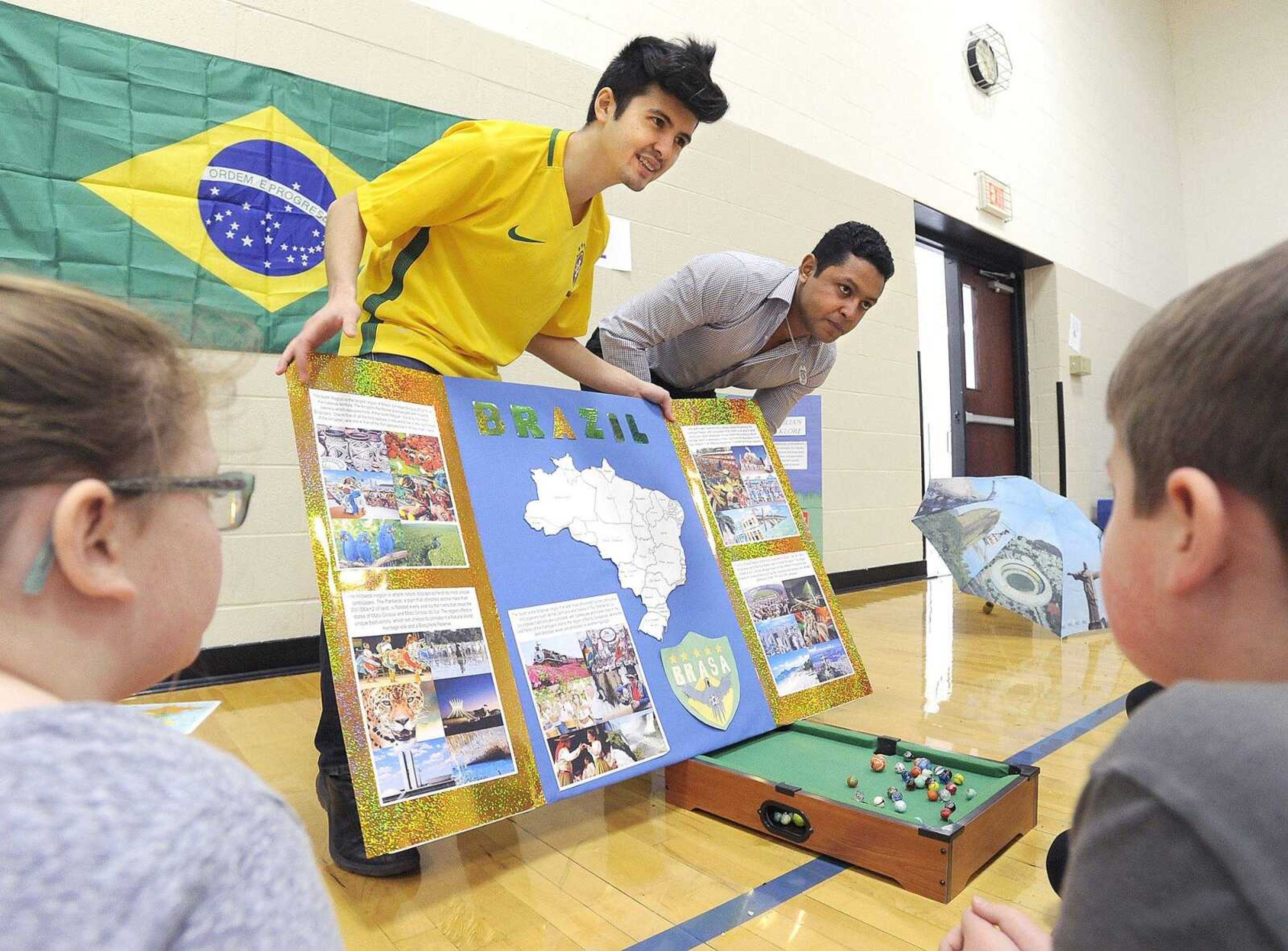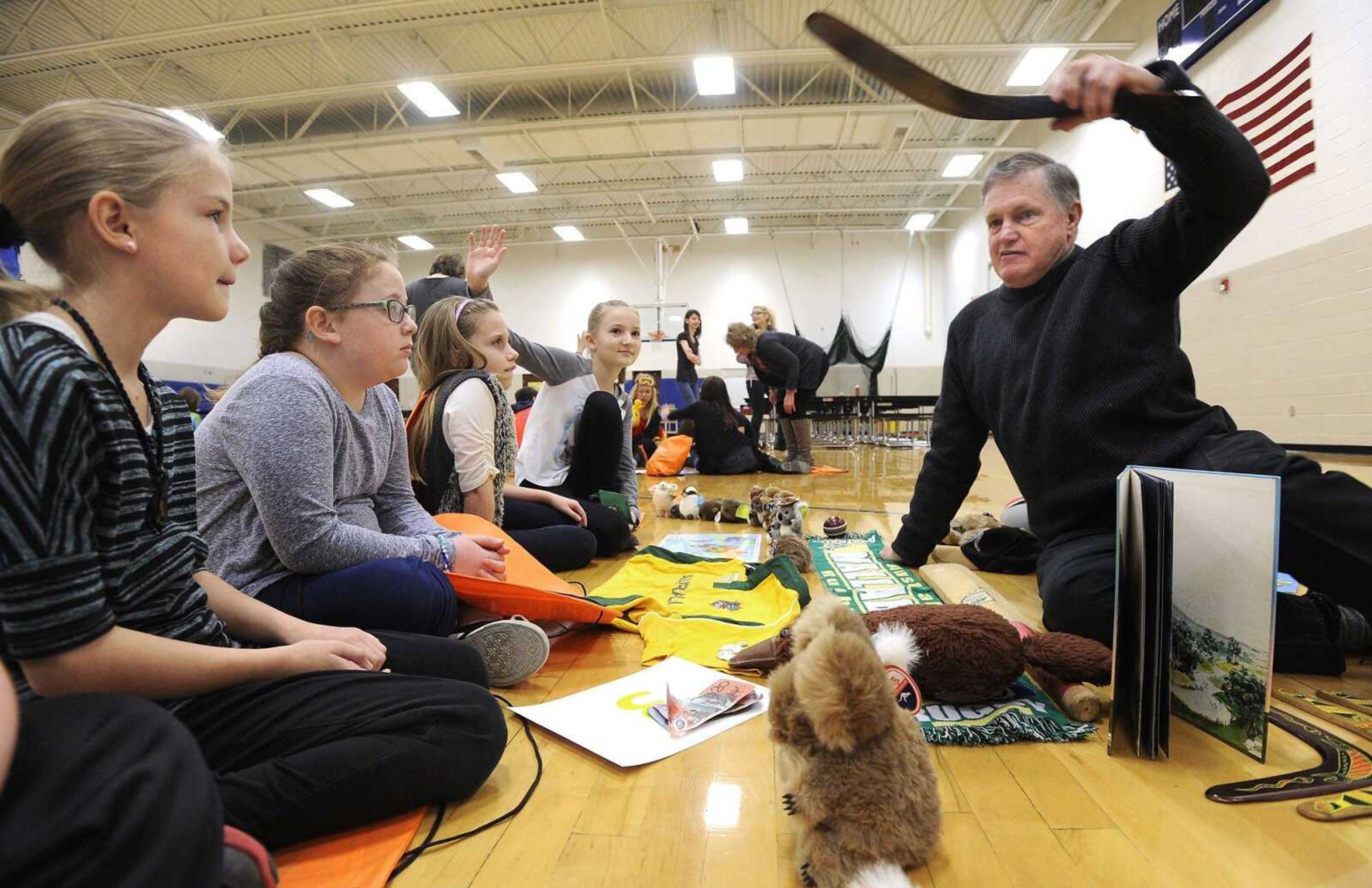World of knowledge: Cultural Exchange Network volunteers give demonstrations to Oran students
A big world opened to some small students Wednesday in a familiar setting -- the gymnasium at Oran Elementary School. Leslie Corn, the director of communications for the Cultural Exchange Network (CENET), held up a world map with help from two of the third- and fourth-graders assembled...
A big world opened to some small students Wednesday in a familiar setting -- the gymnasium at Oran Elementary School.
Leslie Corn, the director of communications for the Cultural Exchange Network (CENET), held up a world map with help from two of the third- and fourth-graders assembled.
She pointed out five countries of interest on the colorful map -- Australia, Brazil, Costa Rica, India and Japan -- and the shaded regions quickly became more real with six visitors.
From the bright-green, large island of Australia was Dr. Peter Gordon; Brazil, which was a darker shade of green, was represented by Marlon Pereira de Amorim and Ricardo Yukio Ashimi Ponce; the central American country of Costa Rica was represented by Brayan Rueda; from the distant pink island of Japan was Yukiho Arikai; and Shvetha Gohn hailed from an orange-colored nation -- India.
The group was there as part of the Culture In The Classroom (CITC) program, which CENET executive director Robyn Walker playfully kicked off as a "wacky" guest from Denmark.

Walker, raised in McClure, Illinois, and who later spent 17 years in Europe, burst into the proceedings with goggles on her head and a giraffe floaty around her waist, proclaiming, "I came over the water to the United States."
After insisting she swam over the ocean, to much laughter, Gordon popped the question, "Do you like meeting people from around the world?"
The group responded enthusiastically, and the tour began.
The 36 students broke into small groups and met the visitors, who had brought items to help explain the culture of their countries.
It was a whirlwind tour, with stops lasting a little more than five minutes each.

It was a different diet of material than the reading or math normally held during that hour.
"They learn about places sometimes they didn't even know existed, just getting to experience a little bit of the food, the language," third-grade teacher Connie White said.
Oran elementary principal Travis Spane said it was the fifth or sixth year the CITC program had visited the school.
"It's a great experience," Spane said. "It's the middle of the United States, so it's nice to broaden our horizon and see what else is out there in the world, and see what we've got from other parts of the world that were actually brought into our culture from them."
Gordon, the director of International Business Programs at Southeast Missouri State University, has lived in Cape Girardeau for more than 30 years, but his voice still strongly suggests "The Land Down Under."

"Every time I go home they say I sound like an American, go figure," Gordon said.
He told the children of the strange, indigenous critters of Australia, which a few stuffed animals on hand bore out, including a platypus and koala bear. He explained the country's most famous animal, the kangaroo, literally means "I don't understand."
His on-hand items included a rugby ball and cricket bat, and he related the objects to the American sports of baseball and football, respectively.
His presentation, which featured an actual boomerang, was the favorite of Rylan White.
"I learned in the old days they used boomerangs to knock out kangaroos," White said.
"They could throw it at them, and if they missed, it would come back, but if it hit them, it would knock them unconscious, and that's how they would capture them."
Gordon offered his visitors a Tim Tam -- a chocolate biscuit -- as their allotted time expired, saying, "Thank you, and enjoy your trip to the next country."
Marlon and Ricardo, students at Southeast from Brazil, also offered a tasty chocolate treat -- a brigadeiro, which consisted of condensed milk and hot chocolate powder.
Ricardo, a sophomore at Southeast, wore a bright yellow soccer jersey in a nod to the country's national sport but also presented marbles as a game many young Brazilians like to play in the dirt.
They emphasized the vastness of Brazil -- it's larger than the continental U.S., excluding Alaska -- and its diversity among regions, noting the heavily forested northwest section that contains pink dolphins in the Amazon, to the popular city of Rio de Janeiro, site of the 2016 Summer Olympic Games, in the southeast, the most heavily populated region.
"A lot of people from all over the world travel to Rio to enjoy the view and enjoy the food," said Marlon, an exchange student, holding up a signature photo of the Christ the Redeemer statue overlooking the city.
He stressed the variant cultures within the states of Brazil, noting differences in dress, food and animals, as well as the regional accents of the people, who speak Portuguese.
Elsewhere, Rueda, who graduated with a master's of science in technology management in May, was showing the rolling green hills and mountainous terrain of Costa Rica, a country about a quarter of the size of Missouri.
"We have small towns and they are surrounded by mountains," Rueda told his audiences. "We don't have many big cities."
It does have volcanoes, lots of them -- 107 to be exact, only of which seven are active.
Rueda displayed pictures of the Rio Celeste, a popular river that gets its multi-colors from minerals, and the country's animals, which include the toucan, a big-billed exotic bird.
Rueda said he's been a part of the CICP program for a while, also visiting schools in Jackson and Cape Girardeau.
"I love talking about my country," Rueda said afterward. "It's beautiful, and not just because it's my country. It's really beautiful. Very tiny but very full of nature."
He added, "It's really cool to talk to kids because they are always interested in learning more about things they haven't seen before."
Gohn had a colorful tapestry for her onlookers to sit on as she taught the students to say "hello" in all three of India's major languages -- Hindi, Tamil and Teluga.
"Tigers are our national animal, and peacocks are our national bird," Gohn said.
Meanwhile, Arikai quizzed her spectators about the red ball on a white sheet of paper, which was the flag from her country, also known as "The Land of the Rising Sun."
The students seemed more familiar with some of the cartoon characters that originated in Japan, like Pokemon.
She also had displayed pictures of sushi and colorful garments, kimonos and yukatas, which she wore on her 20th birthday, an occasion the culture celebrates.
Arikai, a junior studying hospitality management at Southeast, said she participated in CITC last semester at Blanchard Elementary in Cape Girardeau.
"Actually, I am trying to get a job explaining about Japanese culture to the people at Epcot in Disney," Arikai said.
All of the participants were volunteers with CICP, which has been offered free to local schools and organizations since its inception in 2011.
"We love coming to schools like Oran that don't get a lot of special programming," Corn said. "The students love it, and they seem really receptive. And hopefully more schools will use it if they know it's a free resource in the community that really can provide programming that maybe they wouldn't be able to provide on their own.
"We try to come in and make it fun and interactive. It's great for presenters, too, because they get to experience American culture from children, which they may not get, either. I've heard that from a lot of our presenters."
Gordon is a regular community volunteer with CICP, and he said the program plays an important role.
"Particularly in a time when Americans are scared about traveling because they see terrorist attacks overseas and are worried about traveling," Gordon said. "I think it's really worthwhile to try and do as much international outreach as possible."
Connect with the Southeast Missourian Newsroom:
For corrections to this story or other insights for the editor, click here. To submit a letter to the editor, click here. To learn about the Southeast Missourian’s AI Policy, click here.










